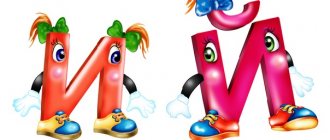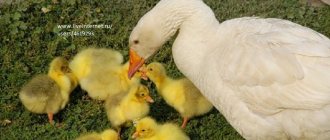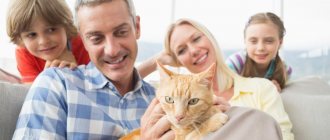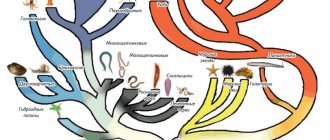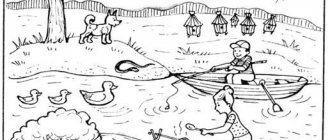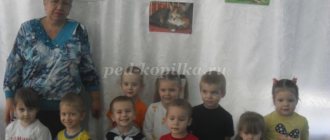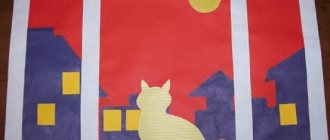Lesson on the formation of lexical and grammatical aspects of speech in the preparatory group for children with speech disorders Topic: “Pets”
Correctional educational goals : Generalization and systematization of knowledge about domestic animals, their appearance and lifestyle. Clarification, activation and updating of the dictionary on the topic: “Domestic animals” (animal, cub, cow, bull, calf, horse, horse, foal, ram, ewe, lamb, goat, goat, kid, pig, wild boar, piglet, rabbit, rabbit, baby rabbit, stable, cost, feeding trough, hay, swill) Improving the grammatical structure of speech (formation and use of possessive adjectives) Correctional and developmental goals : Develop articulatory motor skills, facial muscles, fine motor skills. Develop visual, speech, auditory, creative imagination. Improving the grammatical structure of speech. Educational goals : Developing skills of cooperation, independence, initiative, activity, love and respect for nature. Equipment : Easel, colored pencils, landscape sheet, poster with the image of domestic animals, object pictures depicting domestic animals and their cubs.
Progress of the lesson 1. Organizational moment. - The one who repeats after me the chain of words will sit down: Cat-dog - cow-sheep; Calf - piglet-lamb-puppy; Horse-pig-ram-ox; Foal-kitten-kid-rabbit Educator: Hello, guys! This morning a white-sided magpie flew into my window and brought a letter from my grandparents on its tail. Let's read it! (Takes out a letter and reads: Hello, dear girls and boys. We have a problem - all the animals from our yard have fled. Please help us find them. And to find them, you need to solve riddles.) 2. Guessing riddles . (As you guess, images of domestic animals are hung on the board) Stigma like a cake, Legs with hooves, Thick abdomen, Tail like shavings. (Pig.) He is horned and bearded, Looks sternly at the guys. If someone is being naughty - Gore, gore, gore! (Goat.) The stove is walking, covered in rings. (Sheep) Who exchanges milk for hay? (Cow.) Quick as an arrow, Strong as an ox. In the field - a barge hauler, In battle - an eagle. (Horse.) He caresses toward “his own” people, and swears at “strangers.” In his own little house he sits on the padlock. (Dog.) Emerald eyes, Downy fur coat, Dear songs, Iron claws. (Cat.) Grazes in the meadow, Slowly nibbles the grass, But always reacts to a red rag! (Bull)
I am calm and stubborn, I am the leader in the herd for now. With soft curly fur, I wear horns with a curl. (Ram). Eating carrots, long-eared. If you want, you can take it in your arms. There is a wooden house in a cage. Who lives in it? White Rabbit)
Educator : - Well done guys, all the animals were returned back to the yard. Grandparents are happy with your work. Let's remember which animals we helped bring back? (Pig, goat, sheep, ram, cow, horse, dog, cat, rabbit.) - How can you call all these animals in one word? (Domestic) - Why? (Because they live next to the person who takes care of them...) Educator : Pets live next to the person and are of great benefit. Educator : What does the cow give us? Children : milk, kefir, butter, sour cream, cottage cheese, fermented baked milk. Educator: What does the goat give us? Children : milk, wool. Educator : What does the sheep give us? Children : wool from which thread is spun. Threads are used to knit socks, mittens, sweaters and make woolen fabrics. Educator: How do horses help people? Children : transport goods. Educator: What is the dog doing? Children: guards the house, Educator: What is the cat doing? Children: catches mice. Educator: A person feeds and cares for animals, builds a home for them. 4. Outdoor game: “Horses” (Coordination of speech with movement, development of general motor skills) At the suggestion of the teacher, children go to the carpet and stand in a circle and do familiar exercises. Horses walk in a crowd in the meadow. Walk in a circle with your knees raised high. I can list all the horses: For each name of the horse, bend one finger on both hands. Black as coal, white as snow, Red as a flame is the most beautiful of all. Gray, covered in apples, with a gray mane. The horse is chocolate, very young. Horses graze by the river in a crowd. Walk in a circle again with the knee raised high. Let's count them again with you. Black as coal, white as snow, fingers bend again. Red-haired as a flame is the most beautiful of all. Gray, covered in apples, with a gray mane. The horse is chocolate, very young. 5. Game “Who lives where? » On the magnetic board there are images of the houses of various animals, pictures with images of animals. We select a house for each animal. Children take turns going to the board, selecting a house for the animal, placing it in front of the animal and saying: - The cow lives in the barn. -The dog lives in a booth. -The cat lives in the house. -Sheep, goats and rams live in a barn. -The horse lives in a stable. — The pig lives in a pigsty. — The rabbit lives in a rabbitry. 6. Game “Gather a Family” Educator : All the young animals of our animals are mixed up in the yard, can we help return the young ones to their mothers and fathers? (Yes.) Place the animals of the same family next to each other and tell who is standing next to whom. There is a dog and a puppy next to the dog. Next to the ram are a sheep and a lamb. Next to the bull stands a cow and a calf. Next to the boar there is a pig and a piglet. Next to the horse stands a horse and a foal. Next to the goat stands a goat and a baby goat. There is a cat and a kitten next to the cat. Next to the rabbit stands a female rabbit and a baby rabbit
(You can repeat it - call it a chorus.) Educator : Well done! 7. Finger gymnastics: “We help with the housework.” The cow and the goat must be milked (perform movements with their fists from top to bottom, sometimes clenching and then unclenching their fists, as when milking) S-S-S-S And feed the dog. Gnaw, Bug, bone (they bring their fists to their mouth, hold them on both sides of the mouth, click their teeth, imitating how a dog chews a bone). Give the cat Murka milk to drink. Lak it, lap it, don’t spill it (they bring their cupped palms to their mouth and, bending their head over it, make several movements with their tongue). Shearing the wool from the sheep (bring the index and middle fingers on the right hand together and apart, imitating the movements of scissors). Chick-chick-chick-chick. Harness the horse, set off on the road But-No-No... let's go (sit on a chair straight, straighten your back, hold imaginary reins in your hands, shake them and click your tongue) The horse is carrying a load in a hurry. Hurry up, hurry up (they click at an accelerated pace), And now slow down (they click at a slow pace). Whoa, we've arrived.
8. Game “Find Mom” . (Development of visual attention and perception, fine motor skills. Prevention of impaired written speech)
The teacher offers to look at the pictures.
Educator : What is the name of the mother of the baby puppy?
Children : Dog.
Educator : Find the dog in the picture, trace it along the outline with a simple pencil, and then color it. Educator : Well done, you coped with this task. 9. Summary of the lesson. – Children’s work is assessed; – What animals did we meet today? (Pets.) -Why were they called “pets”? -What domestic animals do you know? -What benefits do they bring to humans?
Educator : Guys, we worked hard today and as a reward for our efforts, grandparents prepared a surprise for us.
